
Sandstone
Purbeck
Polished
Rockery
Flint
Flooring
Sawn
Dinosaur
Durability
Riven
Paving
Granite
Building
Boulders
Walling
History
Technical
Setts
Products
Map
![]()
![]()
The stone that shapes the contours of the Isle of Purbeck and is today quarried for its properties as a building/ornamental material, has deep rooted origins. Apart from the fact that it is part of the geology of the Purbeck hills and was therefore formed in a distant and evolutionary era, the stone has been a part of peoples lives, or should I say livelihoods, for many years. Today its presence in the walls of Dorset homes is welcome, maintaining the character and tradition of the area. Yet it's roots go further than this, not only for a local person charting the beginnings of the Purbeck stone trade and uses of the fruit of its extraction, but also for those who are interested in the heritage of their country and the fact that men quarry today on the Isle of Purbeck what they quarried in ancient times.
A geographical definition of the area may be useful to those not familiar with the Isle. In general terms it constitutes the "extreme south-east corner of Dorset", covers an area of approximately fifty square miles and is surrounded by water on three sides, as well as on part of the fourth, hence the title of 'Isle'. (M. Hutchings, 1967). More specifically the Purbeck Stone Quarries under focus have been described as being situated on "slopes" between Durlston and Worth Matravers. (L. Tatchell, 1954). Thus encompassing Swanage, Langton Matravers, Acton and all the cliff quarries in between. Indeed, Acton arose as a settlement of quarrymen, fuelled and developed as part of the industry. See www.soton.ac.uk/~imw/gif/climbma.gif for coastal map of Purbeck.
Briefly, attention must turn towards some definitions concerning the stone under discussion. Purbeck 'Marble' is not marble as such, rather "a polishable fossily limestone". (R. Legg, 1989) It is a "freshwater deposit" consisting of the fossilised shells of tiny water snails (viviparus) and appears as marble, yet technically is not. This was limestone in its early stages. Following this marble-like state, "Time and pressure changed the sediments of Purbeck in to a smooth and compact crystalline limestone." This so-called marble constitutes only a "wafer-thin outcrop" or "vein", which runs "continuously along the middle of the northern slope of the limestone hills, from sea to sea, between Peveril Point in the east-where the exposed bed runs out in to the waves," and Worbarrow Tout in the west. (D. Pushman, 1997).
More generally, the sedimentary Purbeck rocks are described as having been"deposited in marine and freshwater conditions from about 155 to 45 million years ago." (D. Kemp, 1996). These rocks belong to two main geological ‘systems’or periods; the Jurassic, and the Cretaceous. The layers of stone in this Eastern corner of Dorset began forming in the Upper Jurassic period with the Kimmeridge Clay that lies at the bottom. The Portland Sands are found above this followed by the Portland Beds, the uppermost Freestone Series of which is known as the Purbeck-Portland. On top of this are the Lower Purbeck Beds formed approximately 155 million years ago (mya) in this Upper Jurassic era, deposited in "shallow seas, brackish lagoons and freshwater" and containing "mollusc, fish and reptile remains as well as fossilised dinosaur footprints." (D. Kemp, 1996). Throughout the ages such fossils and footprints have been discovered by quarrymen hard at work splitting open the layers of stone. Most footprints are found in the Roach stratum and such discoveries have become a charming characteristic of Purbeck, a reminder of its fascinating origins and development in an age one can but imagine. The Middle Purbeck strata begins in the Upper Jurassic Period, but from the Cinder Bed upwards is thought to have entered the Lower Cretaceous Period, which began approximately 136 mya, although the boundary for this evolution has been the subject of much debate. The Cinder Bed, a quarryman’s term, constitutes a very dense layer of oysters at the bottom of the Middle Purbeck. Within this Middle Bed are found the Lower and Upper Building Stones, directly below and above the Cinder Bed respectively. Just beyond the Middle is of course the Upper Purbeck which contains the Purbeck 'Marble' discussed previously along with broken shell Limestone. (W. J. Arkell, 1947). See www.soton.ac.uk/~imw/jpg/swanmpg.jpg and www.soton.ac.uk/~imw/jpg/1pumap.jpg (browser note: using right mouse button allows you to open maps in new window) for geological maps of Purbeck.
So, as well as their geological titles the Purbeck Beds have been attributed names by the quarrymen who have worked them throughout the ages. The description of the beds around Acton Common provide a good example of this, and many of the names featured here are repeated in most quarries in the area. At the top is the Rag Stone described by Pushman as ‘crumbly and very good’. Next is the Grub a fine bed able to produce high quality paving stone and fit for varying degrees of polish. Below this is the Roach Bed, mentioned previously, followed by Thornback, a large bed producing ‘blue hued stone’. Lower down is the Whetsun Bed before at the very bottom the Freestone. (Pushman, 1997). This is merely an example and other colloquial names exist to describe the numerous veins and layers throughout the Purbeck Beds.
Ancient Connections
The Roman culture is reported to have been extremely resourceful. When building their great cities, so significant as symbols of wealth and power, the resources of the countryside were utilised by the Romans as far as possible and a reciprocal relationship between these two geographical entities becomes evident. Therefore the use of a natural material such as Purbeck Marble/Stone during the Roman occupation of Britain, mainly for ornamental but also for building purposes, is hardly surprising.
J. B. Calkin points to the 1956 Ordnance Survey Map of Roman Britain that included regional maps, one of which gave coverage to the Dorset and Wiltshire area. He reported that on the Isle of Purbeck marble and shale quarries were shown as well as four sites with pottery kilns. (J. Bernard Calkin, 1968). He goes on to highlight that reciprocal relationship previously mentioned with the landscape offering a valued material and the Romans bringing with them new skills and equipment to aid those already engaged in quarrying. The suggestion is not that the Romans established an industry in Purbeck marble, as it is evident that the beginnings of one already existed, rather that they made the most of the stone as a natural resource and brought an element of efficiency in to the trade.
Discoveries of Roman remains have been made adding weight to the belief that Purbeck Marble was indeed used as far back as the 1st Century AD. The shallow quarries at Wilkswood, behind what is now The Old Malthouse School, are said to have been among the "most ancient workings in Dorset." (Legg, 1989). An extract from the Old Malthouse School Chronicle dated 1942, describes the day that sheep and ox bones, remains of hearths, burnt stones and ash, pieces of Roman pottery, and stone slabs, thought to have once been part of the walls of a stone building, were discovered when one of the quarries was searched in 1941. A broken slab of Purbeck Marble, polished on one face and obviously sawn on another, was found here at the "Roman level". (Old Malthouse School Chronicle, 1942, as quoted in Calkin, 1968).
On this site it is believed that the Romans worked marble, preferring the "greyish-white variety". Legg is unique in discussing the time scale of a marble trade in Roman Britain and identifies two periods of quarrying; from AD 43 to 200, a time of extensive building, and AD 350 to 400 during the country’s economic revival. (Legg, 1989). Other possible sites for Roman workings exist in and around Langton Westwood, but unfortunately today the observer can only speculate when faced with a shallow bowl-like shape in the landscape.
| [Figure 1] | One of many possible locations of shallow Roman earthworks found in and around Langton Westwood. | |
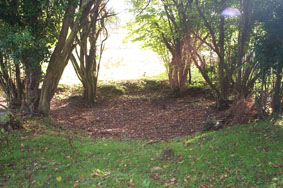 |
Its uses, once quarried, for this industrious Romano-British race were varied. In an earlier writing Legg explains the essential technological advancement of the "rotary quern" made in Roman Britain. Otherwise known as "quern stones" or "mill-stones" many were made out of Purbeck stone. Their importance lay in the fact that they "enabled the efficient grinding of corn". (Legg, 1986). This was a vital innovation expanding the food supply and in turn the population of the country, in which Purbeck stone played its part. |
A common use found at this time for Purbeck was in the production of stone coffins and monumental inscriptions, a trend that has continued to the present day. Their coffins were known as 'sarcophagi' an example of which exists in the tower of St. Mary's Church, Wareham. This is traditionally known as the first resting place of St. Edward the Martyr, the Saxon King allegedly murdered by his stepmother Elfrida at her Saxon home on the site of Corfe Castle in 978. This coffin was carved out of a solid block of Purbeck Marble. In fact more than twelve British graves were discovered in Purbeck, from the time of Roman occupation, in the twentieth century. In most cases the remains had been placed in a "box-shaped structure consisting of upright flag-stones at the sides and ends with cover stones on top." (Calkin, 1968).One of the more "sophisticated" graves was discovered in Atlantic Road, Swanage. This had two walls of stone built up in seven courses and measuring six feet long. The style of the grave and the fact that a bronze brooch was found amongst the remains within it suggested that "this was the grave of some person of substance, perhaps the head of one of the earliest firms of the stonemasons". (Swanage Times, 1953, as quoted in Calkin, 1968). This gives an idea of the status attached to people involved with the industry at this juncture in history. It was also sawn in to slabs after which monumental inscriptions would be carved in to the stone tablets.
It was a luxury product. It provided ornamentation on buildings in the form of cornices and other styles of moulding, made mosaic floors like the one to be found in the Church at Silchester, "the only Christian Church so far known which dates from the Roman occupation of Britain." (Calkin, 1968). Even pestles and mortars made of this material have been dated back to the Roman occupation along with other tools and instruments including anchors with which their boats were moored. Another practical use was as a building material. The more hardy beds of Purbeck Stone were mainly used for this. They buried their dead in it, they adorned their buildings with it and they made technological innovations using it. Purbeck Stone and Marble can be said to have been of considerable importance to the Romano-British race.
A Roman Legacy
These uses extended in to the Middle Ages and Mediaeval period. The stone tombs that can be seen in cathedrals today were a creation of this era, and tombstones as a mark of respect and remembrance for the dead, carved with individual designs, were placed on graves from around the eleventh and twelfth centuries. Examples of these can be seen in the Church of Edward King and Martyr at Corfe Castle and the Church of St. Nicholas at Worth Matravers.
| [Fig: 2] | [Fig: 3] | [Fig: 4] |
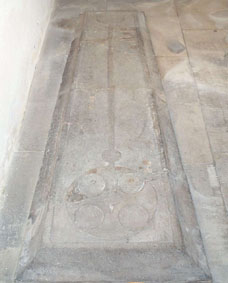 |
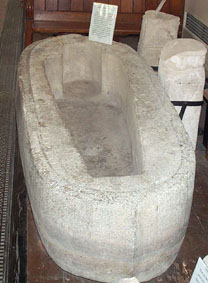 |
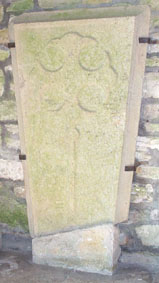 |
Figure 2: Purbeck Marble Tombstone of the type that originated in the eleventh and twelfth centuries, Church of Edward King and Martyr, Corfe Castle. Photographed with permission of Reverend M. Strike.
Figure 3: Thirteenth century Purbeck Stone coffin, dug up in the churchyard of Lady St. Mary's, Wareham, in the eighteenth century. During the nineteenth century it was kept in Saint Edward's Chapel but was removed from here to its current location early in the twentienth century. Photographed with permission of Reverend B. Blakey.
Figure 4: Another monumental slab of Purbeck Marble, dated 1250-1275, discovered quarter of a mile NNE of St. Aldhelms Chapel, Worth Matravers, in the 1950s. Church of St. Nicholas, Worth Matravers.
It soon becomes apparent that ecclesiastical buildings provided significant business to the local stone trade. An extract from the Swanage Times dated 1953 dates the ‘hey-day’ of the industry to the thirteenth century, after its decline up until the twelfth, when Purbeck marble was in great demand according to its suitability in cathedrals and churches particularly with the ‘Gothic’ and ‘Early English’ architectural trends. Apparently from 1190 it became the material of "high fashion" after the Archbishop Hugh Walter decided to build his "Archbishop’s Palace" at Canterbury from it.
Fonts were often made of Purbeck Stone twelve of which are still used in Dorset. The one in Studland Church is thought to date back to Saxon times as part of the original Saxon Church. This simple bowl of Purbeck Stone is beautifully rounded in shape as seen below. Those found in the churches of Corfe Castle and Swanage are slightly more modern examples, the one at Corfe is a fourteenth-century hexagonal font made of Purbeck Marble and is said to have been used as a drinking trough for horses by the roundheads. Other internal features for which marble was used were altar tables and effigies. The earliest effigy that survives in Dorset is that of Philip, a priest who died early in the twelfth century, which now resides at Tolpuddle. Until its replacement by alabaster in the fifteenth century, Purbeck was the supreme material in the production of coffin lids, effigies and the like. A Table Tomb found at the Church of St. Nicholas in Studland is a carved piece of Purbeck Marble.
| [Figure 5] | [Figure 6] |
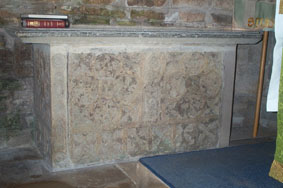 |
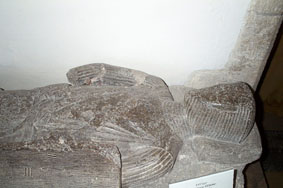 |
Figure 5: Carved Purbeck Marble Table Tomb at Church of St. Nicholas, Studland, unfortunately no inscription or date survives. Photographed with permission of Reverend W. Watts.
Figure 6: Thirteenth century Purbeck Marble effigy of Sir Henry d'Estoke, Sheriff of Dorset in 1200 during the reign of King John. Dated around 1240 due to its style. Lady St. Mary's, Wareham. Photographed with permission of Reverend B. Blakey.
| [Figure 7] | [Figure 8] | |
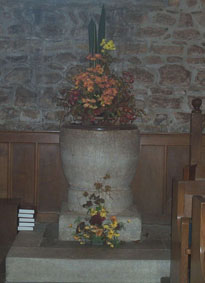 |
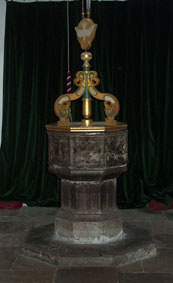 |
Figure 7: Purbeck Stone font,
dates from Norman if not Saxon times, Church of
St. Nicholas, Studland. Photographed with
permission of Reverend W. Watts. Figure 8: Hexagonal Purbeck Marble font, dates from the fourteenth century, Church of Edward King and Martyr, Corfe Castle. Photographed with permission of Reverend M. Strike. |
Purbeck marble was used to adorn the interior of many religious houses like those at Lincoln, Chichester, York, Wells and Winchester. Salisbury Cathedral developed between 1220 and 1258 in the Early English style using much Purbeck. At the same time Purbeck Stone was used in the actual building of the churches. Indeed in the thirteenth century the rebuilding of Westminster Abbey was a huge advance for many local marblers who went on to establish themselves in a London stone trade. Legg comments that their "jobs in London were a mark of complete royal acceptance; it gave Purbeck industry a place inside the closed-shop of building trades". (Legg, 1989). An extension of this royal acceptance can be assumed from the fact that the earliest royal effigy in England, of King John at Worcester, was carved in Purbeck Marble.
Of course the importance of the marble industry to the crown was twofold. Yes they appreciated the beauty of the material and its absolute suitability to the purposes set out above, but apart from this the stone was ‘crown property’ and its profits could only benefit the monarchy. Some have attributed the increase in use during the thirteenth century to this factor; the Purbeck Quarries provided revenue to the royal purse. Furthermore Henry III was renowned for his eagerness to build. (G. Dru Drury, 1948).
Though the area has few royal connections today, it was of great importance in this past period. Corfe Castle was built as a hunting lodge for the monarch due to its close proximity to the New Forest and the building of the original stone structure, built in the later-eleventh century, naturally made use of the local stone. Accounts of the Sheriff of Dorset mentioned in Hutchins’ History of Dorset describe the various stone products supplied under each individual monarch. In 1274 under Edward I, ‘"The sheriff accounts for a marble altar made in Purbeck and delivered to the friars of Mount Carmel in London by the gift of King Henry"’. (As quoted in Drury, 1948).
Legg quite eloquently charts with one sentence the story so far recalled; "Marble working in Purbeck had a forceful Roman beginning, lapsed in the Dark Ages, and was revived in the frenzy of post-Norman England when the gloss was laid upon religion by the erection of the greatest churches ever built." (Legg, 1989). Although it was used for less extravagant domestic buildings, having done a particularly good trade in the seventeenth and eighteenth centuries in roofing and paving stone, Purbeck Stone clearly achieved a high status as material fit to commemorate royalty and encase the worship of God.
Until the Civil War, and the defeat of Lady Bankes and the fortress of Corfe Castle in 1646 by Oliver Cromwell’s men, the industry had been based in the village of Corfe. West Street, running directly up to the entrance to the Castle, was the main thoroughfare and would have been full of masons at work and merchants haggling their prices for the quarried material. Yet after the siege of Corfe Castle the industry within this small village waned. Transport was difficult with the roads full of the fallen masonry that had come tumbling down the hillside that the Castle stands upon, it was no longer a place thriving with trade. This was the point at which the stone trade of Purbeck made Swanage its new home. Yet the nature of the industry remained much the same, with it’s fluctuating success and committed service to religion. The beautiful church in Kingston with the tower that is distinctly noticeable when driving along the road from Langton Matravers towards the Scott Arms Public House was built during a slow period in the 1880s. Designed by G. E. Street, built in the Early English style using a burr stone and Purbeck Marble, the church cost £60,000 to erect. David Pushman suggests that this was a ploy of Lord Eldon, resident of the Encombe Estate that encompassed Kingston, to keep the stonemasons busy in a time of slump. (Pushman, 1997). Whatever the reason the modern observer is grateful to Eldon and Street for providing us with this magnificent example of Purbeck Stone at its best.
| [Figure 9 ] | St. James' Church, Kingston, built in Purbeck Stone and ornamented with Purbeck Marble, 1880s. | |
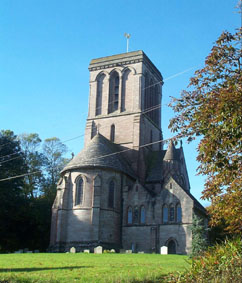 |
Increasingly from the late-nineteenth century Purbeck became renowned for its paving stone, kerbs, channels and setts for guttering; generally as a hardy building material. Additionally with the growing interest in landscaping it offers rockery stone, the background for a water feature and crazy paving for a patio. Over the years it could be said that practicality has become the order of the day. |
Quarrying; a precarious occupation
A vital aspect of the stone trade yet to be addressed is of course the extraction and transportation of the material from its fixed position in the hillsides and cliffs of Purbeck to the merchants and customers all over the country. The shallow Roman earthworks discovered at Wilkswood and the surrounding area have been mentioned, yet as the story progresses through history the details of quarrying become much more dangerous. The men who hollowed out the inland quarries surrounding Corfe Castle, Langton Matravers and Swanage, "sunk shafts some fifty feet down and tunnelled along the seams, some very narrow, with the light of a long candle". (Pushman, 1987). Such underground quarries emerged in the eighteenth century when men would dig down until they hit the first layer of stone. A system of tunnels developed, some had extremely low ceilings and were liable to collapse at any time, killing anyone working below them. A central mine would extend downwards in the form of ‘lanes’ reaching out to the various beds of stone. Each lane began with a slide, or "steep shaft" enabling carts attached to ropes to ferry the stone upwards and out of the mine once dug. (Legg, 1989). After 1800 ropes were replaced by chains allowing the mine shafts to get even deeper. Each lane had a capstan, a wooden drum around which the chain was wound in order to pull the carts full of stone from underground. A wooden bar called a spack was attached to the capstan at one end and a horse at the other that walked in a circular motion around a towpath, pulling the spack that provided the leverage to turn the capstan drum, and therefore the chain and cart full of stone to the surface. The region named Townsend in Swanage boasted the "deepest lanes in Purbeck" apparently the quarries there "have left the most exhausted ground on the Purbeck Limestone." (Legg, 1989). Norman’s quarry in Langton has been preserved and reconstructed by the National Trust as an example of this type of shaft quarry, pictured below with the capstan, chain, wooden spack, and shelter for working the stone in the background.
| [Figure 10] | Norman's Quarry, Castle View, Langton Matravers | |
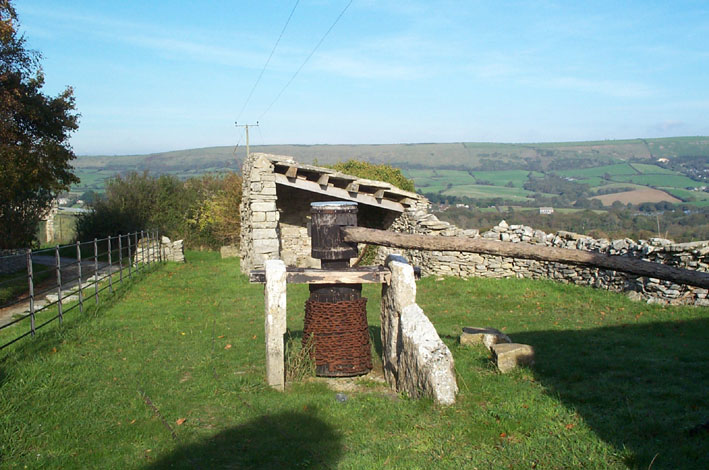 |
During the eighteenth century the extraction of stone remained firmly based in Swanage, however the earth here had been truly exhausted of material and in fear of over-exploitation the trade returned westwards, this time to Langton Matravers and the surrounding coastal cliff quarries that produced the different Purbeck-Portland Stone mentioned above. Legg describes the visit in 1878 of the Inspector of Mines for the West of England to survey the quarryland of Swanage and Langton. He recorded ‘"nearly a hundred stone mines in the Swanage district worked by one, two, or three men underground."’ (As quoted in Legg, 1989). |
Life after extraction
In the early days when stone was dug at Corfe it was exported from Ower Quay a transportation point that had its peak in the Middle Ages as Corfe Castle was being built and the quay existed right on a busy trade route. When bringing loads from Worth, Langton and Acton steep lanes were used so that the journey to Corfe was all downhill. From Corfe the stone was taken across Rempstone Heath to Ower. Once here it is assumed that horses, stabled nearby, dragged their loads along the quay to barges waiting to ferry the stone to the bigger ships anchored further out.
In the same way, after the move to Swanage, the loads were carted down the narrow streets of the town to join the piles of stone known as bankers on the shore. Once loaded carts drawn by horses transported the stone down to the sea where again barges took it out to awaiting ships. These barges, often carrying between six and nine tons in weight, were rowed by two men with oars.
Though the uses of stone are today not too dissimilar from those of the past the actual quarrying of the stone is far from the dangerous underground workings and pick and shovel days of old. Although the quarrymen of our era do use tools to dress stone, in the main heavy machinery cuts in to the quarry face. Lorries have now replaced the horse and cart, barges and ships, that used to underpin the transportation process. The face of quarrying is somewhat altered yet its origins are not forgotten.
| [Figure 11] | [Figure 12] | Figures 11 & 12: | ||
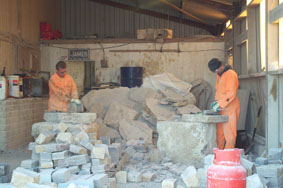 |
 |
Man and machine at work: quarrymen dressing stone and an excavator grading blocks of stone at Swanage Quarries, October 2001 |
Olivia Suttle BA Hons. MA (Leicester) © 2001
Bibliography
Published Sources
W. J. Arkell, The Geology of the Country around Weymouth, Swanage, Corfe and Lulworth (London, 1947)
J. Bernard Calkin, Ancient Purbeck, An account of the geology of the Isle of Purbeck and its early inhabitants (Dorchester, 1968)
E. Bird, Geology and Scenery of Dorset (Bradford on Avon, 1995)
J. Burgess, Dorset, A Guide Historic County Guide Series, Vol. 6 (Carlisle, 2000)
G. M. Davies, The Dorset Coast, A Geological Guide (London, 1964 edition)
G. Dru Drury, ‘The Use of Purbeck Marble in Mediaeval Times’, Proceedings of the Dorset Natural History and Archaeological Society, Vol. 70, 74-98 (1948)
W. M. Hardy, Old Swanage or Purbeck Past and Present, A Collection of Articles, Topographical, Historical, Antiquarian, Biographical, and Anecdotal (Dorchester, 1910)
M. Hutchings, Isle of Purbeck (Sherborne, 1967)
D. Kemp, Environmental Studies in Purbeck: Handbook (Basingstoke, 1996 edition)
R. Legg, Exploring the Heartland of Purbeck (Sherborne, 1986)
R. Legg, Purbeck Island, The industrial, social and natural history of a corner of England (Wincanton, 1989)
D. Pushman, Precious Stones of Dorset (Sherborne, 1987)
D. Pushman, Purbeck Underground (Langton Matravers, 1997)
L. Tatchell, The Heritage of Purbeck, The Notes of a Lover of its Natural History and its Walks (Dorchester, 1954)
We recommend  for books on
line............
for books on
line............
Websites
www.soton.ac.uk/~imw/dorsint.htm I. West, Department of Ocean and Earth Science, Southampton University (2001)
www.purbeckstone.com J. Suttle Swanage Quarries (2001)
Acknowledgements
Thanks to Ian West at the School of Ocean and Earth Science, Southampton University for use of the geological information and superb location maps on his website. Appreciation also to the Reverend Strike (Edward King and Martyr, Corfe Castle), Reverend Watts (St. Nicholas, Studland), and Reverend Blakey (Lady St. Mary's, Wareham), who gave me permission to take photographs of some of the ancient Purbeck Stone and Marble features in their Churches. Last but not least, thanks go to my father, Chris Suttle, who gave me the opportunity to research this fascinating element of local history.
Olivia Suttle BA Hons. MA (Leicester) © 2001
Swanage, Dorset, BH19 2QS
+00 44 (0) 1929 423576 (facsimile 427656)